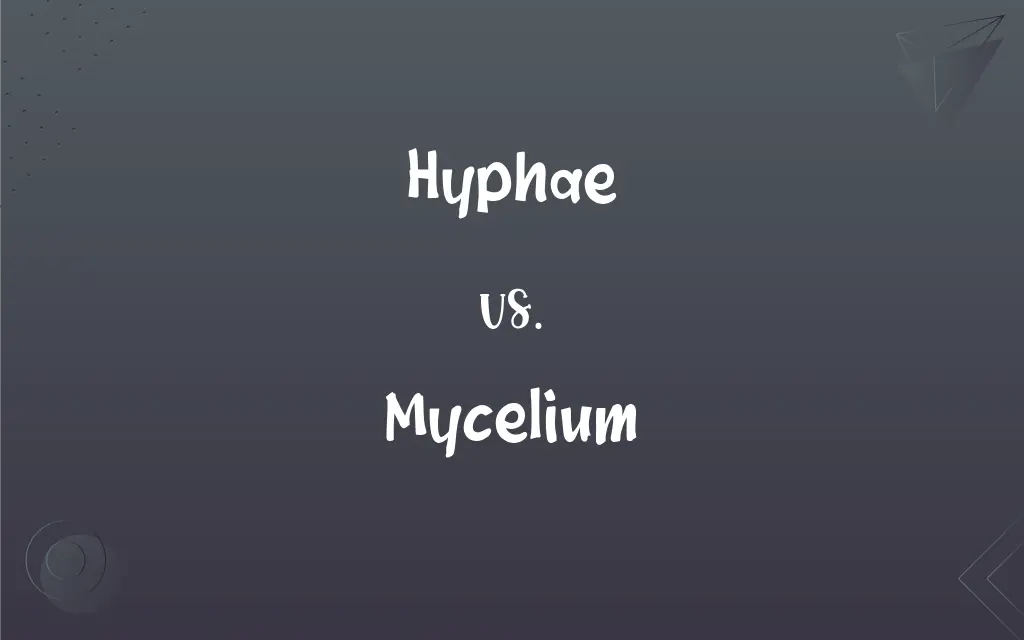Hyphae vs. Mycelium: What's the Difference?
Edited by Harlon Moss || By Janet White || Published on January 10, 2024
Hyphae are the individual, thread-like filaments in fungi, while mycelium is the network of hyphae forming the main body of the fungus.

Key Differences
Hyphae are the building blocks of a fungal organism, consisting of long, thread-like structures that grow and branch out. Mycelium, on the other hand, refers to the collective mass of these hyphae, forming the main vegetative part of the fungus.
Each hypha is a separate filament that can absorb nutrients and water, essential for the growth and survival of the fungus. Mycelium, as a network of hyphae, acts like the 'roots' of the fungus, expanding into the growth substrate to support the entire organism.
Hyphae can be microscopic and single-celled, visible only under a microscope. In contrast, mycelium can become quite extensive, often visible to the naked eye as a white or colored mass on growth substrates like soil, wood, or decaying matter.
The structure of hyphae varies, with some being septate (divided by cross-walls) and others coenocytic (without cross-walls). Mycelium, encompassing various types of hyphae, forms complex structures adapted to different environments and functions in the fungus.
In reproduction, specific hyphae can differentiate to form reproductive structures, such as spores. Mycelium primarily focuses on growth and nutrient absorption, providing the foundation for reproductive structures to develop and release spores.
ADVERTISEMENT
Comparison Chart
Definition
Individual filaments in fungi
Network of hyphae
Visibility
Microscopic, single-celled
Often visible as a mass
Function
Nutrient absorption, growth
Supports the fungus, nutrient network
Structure
Can be septate or coenocytic
Complex structure of interconnected hyphae
Role in Reproduction
Can form reproductive structures
Supports reproductive growth
ADVERTISEMENT
Hyphae and Mycelium Definitions
Hyphae
Hyphae are the thread-like structures in fungi.
The hyphae absorb nutrients from the decaying wood.
Mycelium
Mycelium forms the main body of the fungus.
The mycelium network is extensive in this forest soil.
Hyphae
Hyphae can be septate or coenocytic.
The septate hyphae in this sample have distinct divisions.
Mycelium
Mycelium is visible as a white or colored mass.
You can see the mycelium growing on this bread.
Hyphae
Hyphae are responsible for nutrient uptake.
Hyphae extend into the soil to access water and minerals.
Mycelium
Mycelium is the mass of hyphae in a fungal organism.
The mycelium spreads through the compost, decomposing it.
Hyphae
Hyphae can differentiate into reproductive structures.
Some hyphae have developed into spore-producing bodies.
Mycelium
Mycelium aids in nutrient distribution within the fungus.
The mycelium transports nutrients to the growing mushroom.
Hyphae
Hyphae are the basic structural units of fungi.
Hyphae grow and branch out as the fungus spreads.
Mycelium
Mycelium provides structural support for fungi.
The mycelium anchors the mushroom to the ground.
Hyphae
Any of the threadlike filaments forming the mycelium of a fungus.
Mycelium
The vegetative part of a fungus, consisting of a mass of branching, threadlike hyphae.
Hyphae
Any of the threadlike filaments produced by certain bacteria.
Mycelium
A similar mass of fibers formed by certain bacteria.
Hyphae
Plural of hypha
Mycelium
The vegetative part of any fungus, consisting of a mass of branching, threadlike hyphae, often underground.
Hyphae
The long, branching filaments of which the mycelium (and the greater part of the plant) of a fungus is formed. They are also found enveloping the gonidia of lichens, making up a large part of their structure.
Mycelium
The white threads or filamentous growth from which a mushroom or fungus is developed; the so-called mushroom spawn.
Mycelium
The vegetative part of a fungus consisting of a mass of branching threadlike hyphae
FAQs
Do all fungi have hyphae?
Most fungi have hyphae, but there are exceptions.
How do hyphae contribute to fungal reproduction?
Some differentiate to form reproductive structures like spores.
Can mycelium spread far?
Yes, mycelium can spread extensively in its substrate.
Can hyphae be seen with the naked eye?
Generally, they are microscopic and require a microscope to be seen.
How do hyphae grow?
They grow by extending their tips and branching.
What is the main function of hyphae?
Hyphae absorb nutrients and water for the fungus.
What are septate hyphae?
They are hyphae divided by cross-walls.
What is the primary role of mycelium in fungi?
Mycelium serves as the main body, supporting growth and nutrient absorption.
Is mycelium visible in all fungi?
In many fungi, yes, especially when they form a dense network.
Do hyphae have a role in decomposing organic matter?
Yes, they break down organic matter for nutrient absorption.
Can you cultivate mycelium?
Yes, it's cultivated for food, medicine, and other uses.
Are hyphae single-celled or multicellular?
They can be either, depending on the type of fungus.
Is mycelium harmful to plants or animals?
It depends on the fungus; some are symbiotic, others can be pathogenic.
How does mycelium affect soil health?
It can improve soil structure and nutrient cycling.
How does mycelium respond to environmental changes?
It can adapt its growth and network based on available resources and conditions.
Does mycelium have a specific color?
It's often white but can vary depending on the fungus and substrate.
What's the difference between mycelium and a mushroom?
Mycelium is the vegetative part, while a mushroom is the reproductive structure.
Can mycelium be used in biotechnology?
Yes, for things like bioremediation and creating sustainable materials.
Do hyphae release enzymes?
Yes, they release enzymes to break down complex substances.
Can hyphae form symbiotic relationships?
Yes, such as in mycorrhizal associations with plant roots.
About Author
Written by
Janet WhiteJanet White has been an esteemed writer and blogger for Difference Wiki. Holding a Master's degree in Science and Medical Journalism from the prestigious Boston University, she has consistently demonstrated her expertise and passion for her field. When she's not immersed in her work, Janet relishes her time exercising, delving into a good book, and cherishing moments with friends and family.
Edited by
Harlon MossHarlon is a seasoned quality moderator and accomplished content writer for Difference Wiki. An alumnus of the prestigious University of California, he earned his degree in Computer Science. Leveraging his academic background, Harlon brings a meticulous and informed perspective to his work, ensuring content accuracy and excellence.







































































